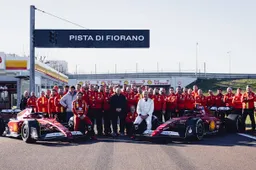
Scuderia Ferrari team principal Frederic Vasseur addressed the squabble between his two drivers during and after the 2024 Spanish Grand Prix.
Charles Leclerc and Carlos Sainz claim to have an amazing, friendly relationship off the track, but every time they meet on the track, they don't go easy on each other at all.
The two had many close calls in the past, where their battle almost ended with an incident, and in Barcelona, they came perhaps closer than ever before.
The two Scuderia drivers made contact as the Spaniard was trying to overtake the 26-year-old on lap three going into turn number one.
Sainz overtook Leclerc, but the Monegasque apparently suffered a bit of damage to his front win. After the race, Leclerc asserted he was disappointed by his teammate's actions (who ultimately finished behind him either way) and that he could have finished in P4 if it hadn't been for that overtake from Sainz.
Speaking to the media after the race, Ferrari team principal Fred Vasseur dismissed the importance of the battle. He suggested there were many more occasions throughout the race where Leclerc lost half a second (the gap to George Russell at the finish line). As quoted by Motorsportweek.com, he said:
"You can find ten examples of 10 circumstances in the race where we missed half a second or others that were after when Carlos let him go also later on. We missed a couple of tenths during two or three laps."
Read also
"Let us discuss and not to draw a conclusion after the first comment of the driver when he jumped out of the car."
Leclerc suggested that it was pre-agreed that he and his teammate would manage their tires in the last turn to gain an advantage later in the stint, which Sainz ultimately didn't do, which is why he got the overtake done. Vasseur added:
"We don't speak like this about the strategy of the race. But we knew before that if you have a look on all the races in Barcelona for 25 years now, the first stint is a bit boring. It's more to take position on track."
"And then when you start the pit stop to have still potential into the tire to push. And it was more the approach, but it's not that don't push turn one, don't push turn two."
Read also
POPULAR NEWS

Steiner Warns Red Bull: 2024 Performance Masked By Verstappen's Brilliance

Sainz Sr. Grateful For Ferrari's 'Fantastic Gesture' After Driver Switch

Marko Issues Honest Verdict On Verstappen's Potential Exit: 'You Have To Be Realistic'

Racing Bulls CEO Reveals What Verstappen's Personality Is Like Outside F1 Paddock

Magnussen Discusses 'Crazy' Thing That Separates Verstappen From Hamilton And Others

Hamilton: Driving Ferrari F1 Car For First Time 'One Of Best Feelings Of My Life'
Loading

